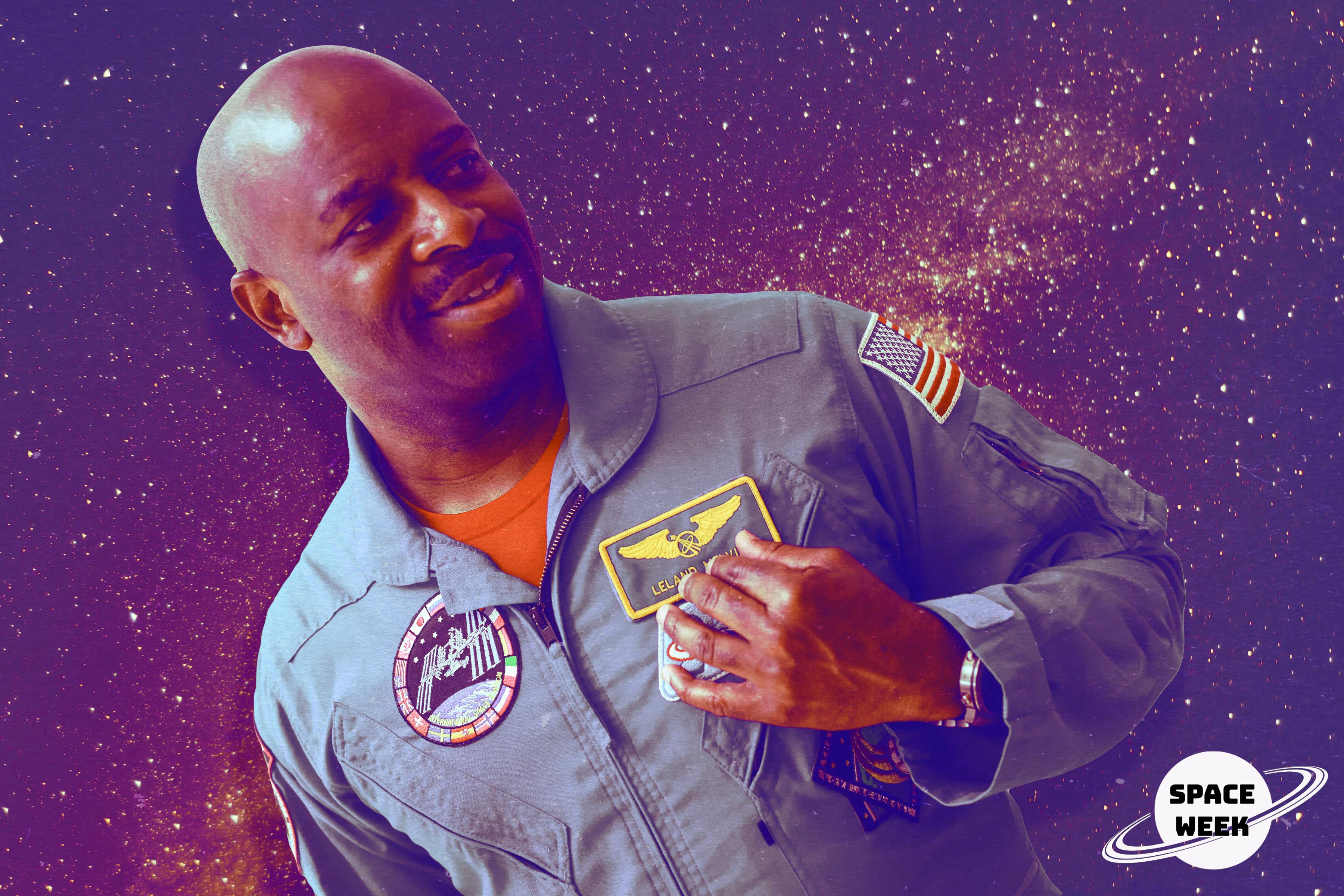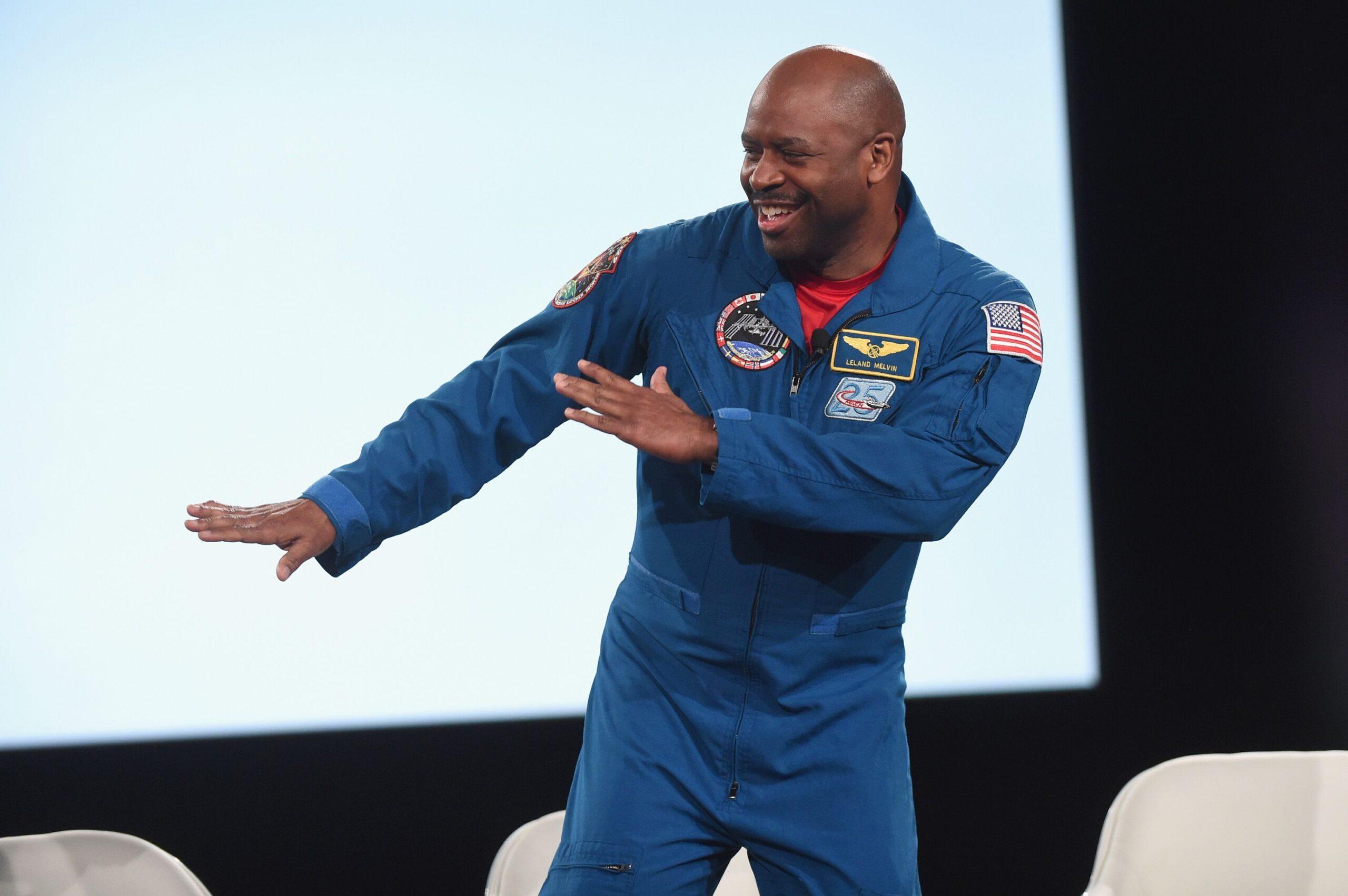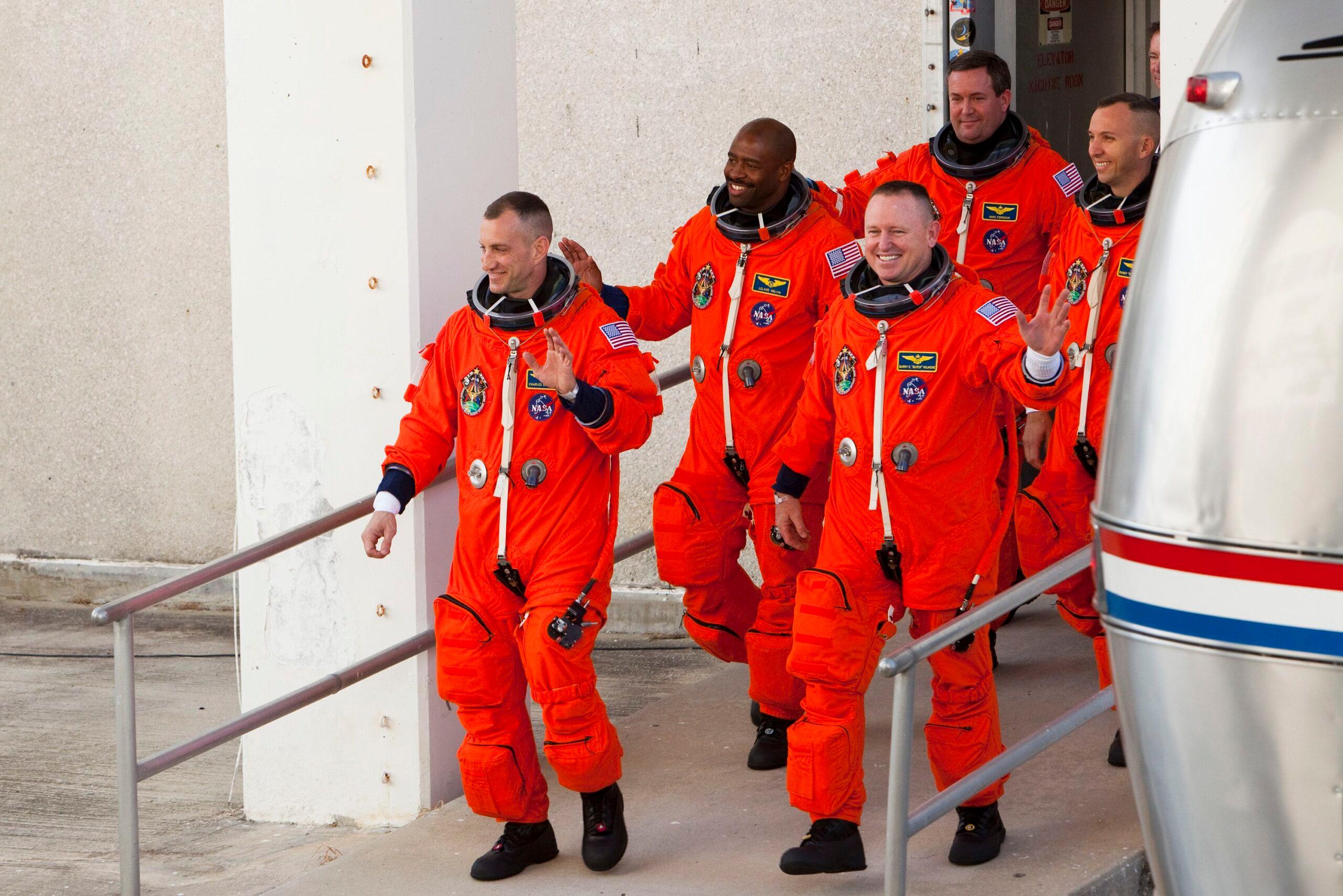Space Travel and Football, That’s What Melvin Does!
Astronaut Leland Melvin has lived two dreams, getting drafted by the Detroit Lions and twice serving on missions to the International Space Station. The modern-day Renaissance man may have retired from NASA, but he’s far from finished trying to make a difference in the world.
As astronaut Leland Melvin would float through space on board the NASA shuttle Atlantis, looking down at faraway Earth, what would always catch his eye was the water: so much water, in so many colors, in more shades of blue than he ever had words for. So he took pictures instead, pointing his camera out the window, zooming in on icy polar shores and Bahamian cays and delicate ring-shaped atolls. “I’m an Aquarius, so, the water bearer,” says Melvin, who’s speaking by phone in early September from his home in Lynchburg, Virginia, while taking a break from binge-watching Game of Thrones. (He’s through Season 6, Episode 8, so no spoilers.) “I just love water, I love floating, I love being immersed. My favorite color is blue. To have your mind just get blown by looking out the window, it’s transformative.”
Melvin has been to space twice, once in February 2008 and again in November 2009, on missions that involved visiting the International Space Station to install research laboratories and transport ISS personnel. As a kid growing up in Lynchburg who was fascinated by both sports and science, Melvin took both enthusiasms to the extreme. A former University of Richmond wide receiver, he was drafted by the Detroit Lions and also spent time in Dallas Cowboys training camp. When a recurring hamstring injury brought an early end to his professional football days, he soared even higher in his subsequent career, a 24-year tenure at NASA that took him from an optics lab into outer space.
Over the years, both up to and since his retirement from NASA in 2014, his work as an astronaut has also led to all sorts of earthly delights. He met Barack Obama. He broke through the internet’s stratosphere when his official NASA portrait, featuring him and his two extremely good dogs, went mega-viral.
He brought Lions and Cowboys jerseys into space; they now live in the Pro Football Hall of Fame. He appeared on an episode of Dog Whisperer, hosted a couple of seasons of Child Genius, and was a judge on Top Chef and BattleBots. He introduced former NASA mathematician Katherine Johnson to musician and space nerd Pharrell Williams, who later worked as a producer on the film Hidden Figures, about Johnson’s life.
He is a modern-day Renaissance man who, between football and space travel, lived two American dreams. But seven years before Melvin’s first lift-off, this cosmic career nearly ended, in a nightmarish manner, before it had a chance to begin. And the reason was a pool filled with 6.2 million gallons of Melvin’s beloved water.
It was April 2001, Melvin’s first day of spacewalk training at the NASA Neutral Buoyancy Laboratory near the Johnson Space Center in Houston, a facility designed to mimic the weightlessness of space by lowering astronauts, clad in specially weighted marshmallowy spacesuits, as much as 40 feet underwater to perform tasks on a replica of the ISS. As he descended into the pool, excited for the first step in what he hoped would culminate in a visit to the great unknown, Melvin felt pressure building inside his head and moved his face toward his helmet’s Valsalva device, a sort of hands-free V-shaped styrofoam stand-in for pinching your nose with your fingers to help your ears pop.
But there was no Valsalva device in his helmet; a technician had failed to install it. The next few hours were a blur of being removed from the water tank, seeing nothing but worried faces and hearing nothing but static, bleeding from one ear, spending time isolated in a steel altitude chamber, visiting numerous doctors, and emerging without hearing and without any clear diagnosis as to why. He was placed on the astronaut’s version of the disabled list, designated “Duty Not Involving Flying,” or DNIF, a worst-case-scenario label that made it highly unlikely he’d ever be declared fit to go back into the pool, let alone into orbit.

“I think the way I reacted after I got injured,” Melvin says, “was, I wasn’t yelling and screaming and freaking out. I was just like, you know, we’re gonna figure this out.” And looking back, he credits a perhaps-unexpected source for such grace under literal pressure: his time as a top-flight football player.
Recruited out of Lynchburg in 1982 by the University of Richmond, Melvin remains fourth all time for the Spiders in career receptions (198) and yardage (2,669) and likes to joke about how, for a hot minute one season, he was statistically neck-and-neck with Mississippi Valley State’s Jerry Rice in catches per game. Melvin was drafted in the 11th round of the 1986 draft by the Lions, but while he caught three passes that preseason for 45 yards, recurring hamstring issues led to his release by the Lions and, later, by the Cowboys. Still, he routinely drew on his athletic experience as he established his career with NASA.
“I think a lot of it came from football,” he says. “You know, fourth-and-long, you have, you know, tens of thousands of people screaming at you, or for you. And you know you’ve got to catch the ball, or you don’t win. That repetition, from a very early age, of having to catch the ball, or do something, or have a clutch play — that training set me up for getting ready for space, and having the right type of mentality.”
During Melvin’s senior season at Richmond, a 1985 college football roundup in Sports Illustrated called the wide receiver “sure-handed” but noted that “at a 7:30 a.m. lab last spring he dropped hydrochloric acid on himself and burned a dandy hole in his blue jeans.” It wasn’t the first time he’d had such an incident. When he was about 8 years old, his parents, Deems and Grace, encouraged his fledgling interest in science by buying him a chemistry set.
“One of those age-inappropriate models that had the potential to do some real damage,” Melvin wrote in his memoir, Chasing Space: An Astronaut’s Story of Grit, Grace, and Second Chances, which was released earlier this year. “The kind that was soon taken off the market.” One afternoon, when an experiment led to a sizzling carpet and lots of smoke, “my mother rushed into the room expecting to find me injured,” he wrote. “Instead she found me sitting on the couch with a dumb grin on my face. Somehow, I had used the power of those clear liquids to unleash fire and brimstone in my house.” And so a young scientist was born.
That repetition, from a very early age, of having to catch the ball, or do something, or have a clutch play—that training set me up for getting ready for space.Leland Melvin
“Melvin shared the award for the outstanding chemistry student in the junior class,” said the 1985 SI piece, “and this summer he did lab research for a professor on — get this! — the downfield chemical shifts of halogenated amine-boranes on the nuclear magnetic resonance (NMR) spectrometer. Melvin is planning to attend graduate school in chemical engineering. The only question is whether he’ll go full time or between NFL seasons.”
He wound up enrolled in graduate classes in materials science engineering at the University of Virginia at the same time he was at Dallas Cowboys minicamp under head coach Tom Landry, juggling time on the field with time spent watching videotaped versions of crystallography classes that he’d missed. (At one point, he wrote in Chasing Space, he multitasked by using the Fortran 77 programming language on his new Zenith laptop computer to create electronic flashcards of the Cowboys playbook. When his UVA classes had tests, he’d go to nearby Southern Methodist University to take them in front of a proctor.) When his hamstring acted up again and the Cowboys cut him, Melvin was frustrated; he felt as if he hadn’t been given enough of a chance to prove himself and rebound from his injury. But his education provided more than enough distraction from his disappointment, and he turned his attention to his studies full time. During a job fair near campus in 1989, Melvin was approached by a NASA recruiter who had, as part of a diversity initiative, been dispatched to Charlottesville with a list of names of promising students to pitch on joining the agency. Melvin was one of them.
Which is how he wound up working with glass fibers in a NASA optics lab, and how, several years later, he wound up giving a presentation to a group including astronaut John Young, a man who had flown on Mercury and Apollo, who had walked on the moon, and who ultimately encouraged Melvin to apply for the extremely selective astronaut program. Having seen some of his fellow NASA employees apply over and over for the competitive program for years without any success, Melvin hadn’t really thought he’d stand much of a chance. But following a grueling battery of psychological assessments and nerve-racking interviews and essays and physical-fitness tests, Melvin got a call in 1998: Out of a pool of 2,500, he was one of 25 American astronauts (joined by six international candidates) accepted into astronaut training — on his first try.
The music producer Quincy Jones, much like Williams, has a longtime love for space; in 1964, he did an arrangement of the then-decade-old song “Fly Me to the Moon” for Frank Sinatra, and after Jones found out that Buzz Aldrin had played his arrangement up among the stars, he was inspired to title his 1969 jazz album Walking in Space.
“Quincy Jones,” Melvin says, “one thing he does is every country he goes to, he learns how to say hello, thank you, and goodbye. So he knows how to say that in, like, a billion languages.” During Melvin’s astronaut training, he found himself learning more than just that. Stationed in 1999 in Russia’s “Star City,” an astronaut training base outside Moscow that doubles as a way station for astronauts getting set to deploy to the International Space Station via the Baikonur Cosmodrome in Kazakhstan, Melvin learned as much Russian as he could and learned that many geopolitical differences melted away when the conversation focused on three things: music, food, and family. “We’d go to this market,” he says, “and buy bootleg CDs and food and just be open to the possibilities of people coming together.”

After a couple years in Russia, Melvin came back to the U.S. to begin extravehicular training — basically, to learn how to spacewalk. The first step, and seemingly the last, was the fateful pool training. In the months that followed the accident, Melvin’s hearing slowly began to creep back, though not enough to cause doctors to clear him. Sidelined indefinitely, and most likely permanently, from any extravehicular training, Melvin instead began working in NASA’s robotics branch, learning how to operate a robotic arm, and also spent time in the education division, developing programs to reach out to educators and children.
In 2003, during a trip home to visit his family, he received word that the shuttle Columbia, while returning from a mission, had broken up during reentry through the earth’s atmosphere, killing everyone on board in a disaster made particularly tragic by the fact that the spacecraft’s catastrophic damage had been caused weeks earlier, during takeoff. Like the 1986 Challenger explosion had done, the Columbia accident led to the shutdown of the space shuttle program for a time. After the incident, Melvin went to visit the family of David Brown, an astronaut on board who was also a close friend of Melvin’s, and had a conversation with Judge Paul Brown, David’s father, that Melvin would never forget.
“He said to me, ‘My son is gone, there’s nothing you can do to bring him back,’” Melvin says, “‘But the biggest tragedy would be if we don’t continue to fly in space to honor them, to continue on their legacy.’ He’s talking about the legacy of his son and the crew, and I’m crying, and we’re all crying and I just think about — they gave their life to help us advance our civilization, and they died as heroes.”
As Melvin crisscrossed the country in the days and weeks that followed, attending numerous memorial services for his late colleagues, he didn’t realize that he was being observed by NASA’s chief flight surgeon, who was watching Melvin closely for signs of discomfort during takeoffs and landings. Satisfied by the way Melvin seemed to handle the various changes in altitude with no problem, the surgeon surprised him with some news: He had decided to issue Melvin a medical waiver so that he could go to space. For Melvin, who had once been told by a Navy fighter pilot and NASA shuttle commander that there was no chance he’d ever go into orbit — and that he should consider suing the agency because of it — this was an unexpected and exultant development.
Several years of training later, as Melvin sat strapped in his seat and listening to the final countdown before his own launch, Judge Brown’s words echoed through his mind. “So there was no moment of fear,” Melvin says. “I didn’t have time for fear, because I had to do my job to honor the fallen heroes again. It was really powerful for me to have had that experience with his father about the accident.” While Melvin had regained the majority of his hearing, doctors had never been able to explain what caused the loss; he was never allowed back in the Buoyancy Lab training pool, which meant that during his mission, he couldn’t leave the shuttle and spacewalk. Instead, he operated the robotic arm of the Atlantis from inside the shuttle. Still, he woke up every morning to some music he had brought on board: a copy of Jones’s Walking in Space.
In addition to grooving to jazz in the mornings, Melvin tossed a football onboard the shuttle and captured floating M&Ms in his mouth like some three-dimensional Pac-Man. He grew so accustomed to the Segway-like nature of weightless propulsion while in space that it led to a comical nighttime situation once he was back on Earth.
“If you have to pee in space in the middle of the night,” he explains, “you just kind of push off and float over and do your business and then fall back. So, [back home,] I wake up and I’m laying on my back and trying to push off, trying to float over, and that’s not working. Then I roll over on the ground floor, and I’m like ‘I don’t get it.’ And I have to crawl to the bathroom before I figure it out.”
I didn’t have time for fear, because I had to do my job to honor the fallen heroes again.Melvin
He video-chatted with family and operated the cranelike robotic arm during spacewalk operations and kept up with exercises designed to counter the physical effects of being in space. He missed his pups Jake and Scout, whom he would later sneak onto NASA grounds for the 2009 astronaut photo that continues to make the feel-good rounds on the internet to this day. (His favorite part about the photo, which besides being so freaking cute also has the pyramidal composition of a Renaissance painting, is that the three of them appear to all be holding hands.) And he took photos of his own during his downtime, of Earth’s continents and the vast expanses of water that surround them.
Melvin wasn’t in space during hurricane season, so he didn’t look down upon any of those distinctive ferocious whorls. But he still saw other phenomena playing out on the planet. “I saw some big storms over Africa coming home on my first mission,” he says. “I’ll never forget that — you could see lightning going across the entire continent through the clouds, a light show happening, and I was like, ‘Wow, that’s a lot of energy — think about how many electric cars you could drive.’”
He saw fires burning, and the effects of deforestation in the form of sediment making its way down rivers like the Amazon and the Mississippi. Between his first mission in February 2008 and his second one in November 2009, he noticed a glacier that had decreased in size. “You know obviously it’s going to affect people,” he says. Melvin typically speaks in a calm, deliberate manner, but he gets audibly agitated when discussing the importance of acknowledging climate change. “This is our planet, and this our children’s children,” he says. “We get so myopic on, ‘Hey, OK, I’m gonna be OK for the next 20 years, I’m good,’ but we don’t think about our future generations. And that’s the short-sightedness of all of this.” He does what he can to combat this, mostly through a continuing focus on those children’s scientific education.
When Melvin appeared on the C-SPAN show Book TV a few weeks ago to discuss Chasing Space and take questions from callers, someone, he says with exasperation, rang to ask if the moon landing was faked. (In 2002, when a conspiracy theorist ambushed Aldrin with a similar question, Aldrin ambushed the conspiracy theorist with his fist.) And when an astronaut friend of his visited Hurricane Harvey victims in Houston, a kid asked her whether the Earth is really round.
For someone like Melvin, such conspiracy theories and retreats from established scientific doctrine can feel personal. After all, Young, the astronaut who first urged him to apply for the training program, was part of a moon mission long ago. “He’s always been an admirable person,” Melvin says. “He wasn’t a liar.” And given his dedication to speaking to and working with children (there’s even a kids version of Chasing Space) and his own memories of discovering and loving science when he was a boy, to hear of a kid parroting flat-earther nonsense is tough to take. Still, Melvin presses ahead, as he always has, hoping his visibility and his unusual career path can continue to give him a platform to teach and a constant opportunity to learn.
He points to a pair of iconic photos taken by astronauts that he says were instrumental in pushing the fledgling environmentalist movement forward right around the time of the formation of the EPA: the classic 1972 photo called Blue Marble that was taken by the crew of Apollo 17; and the earlier 1968 picture known as Earthrise that was snapped by Bill Anders of the Apollo 8 crew and depicts the bright greens and brighter blues of Earth rising up over the drab gray lunar horizon, like a lush Freaky Friday production starring the third rock from the sun and its moon.
In The New York Times that year, poet Archibald MacLeish wrote, of the Earthrise photo: “To see the Earth as it truly is, small and blue and beautiful in that eternal silence where it floats, is to see ourselves as riders on the Earth together, brothers on that bright loveliness in the eternal cold — brothers who know now they are truly brothers.” Blue and beautiful, floating forever: Maybe, like Melvin, the planet Earth is at heart an Aquarius, too.

